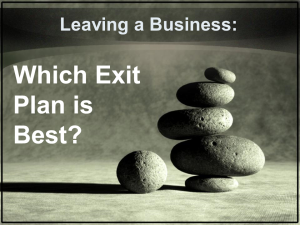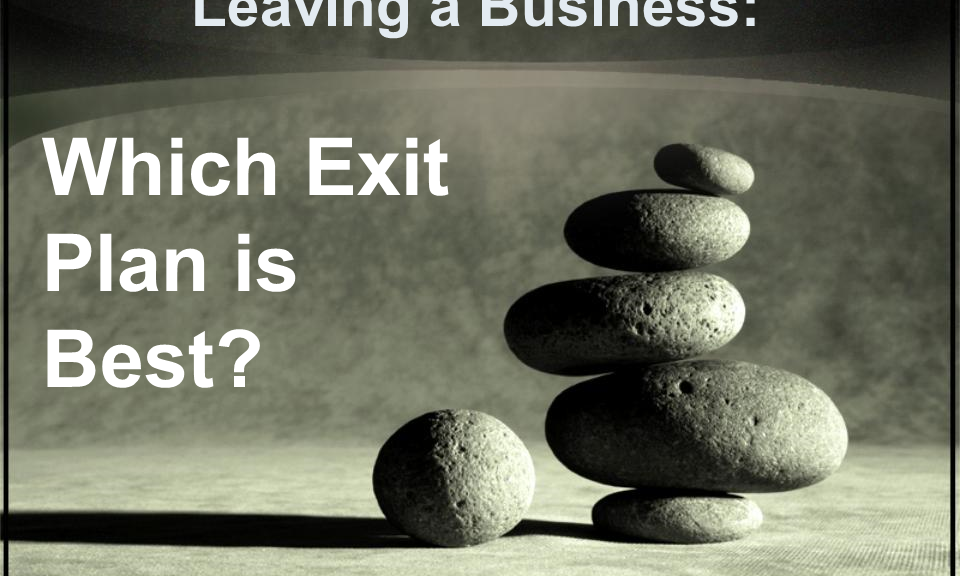Which Exit Plan is Best?

Selecting which exit plan is best and your best business successor is a fundamental objective of planning an exit strategy and requires a careful assessment of what you want from the sale of your business and who can best give it to you.
At HubCFO we believe in a balanced approach to divesting from the business examining each and every option … and being prepared to move forward with any suitor … from whichever exit plan was best. Ask us about the company we sold 11 days before 9/11 … all for cash … and thankfully right on schedule, which none of the other participants could believe! If not for our disciplined approach and readiness for the transaction, in this case any delay of 12 or more days would have delayed the transaction for years and would not have been executed for the same dollar amount until years later.
There are five ways to leave your business: transfer ownership to family members, Employee Stock Option Plan (ESOP), sale to a third party, Initial Public Offering (IPO) and liquidation. The more you understand about each one, the better the chance is that you will know which exit plan is best for you and leave your business on your terms and under the conditions you want. With that in mind, here’s what you need to know about each one.
-
Transfer Ownership to your Children
Transferring a business within the family fulfills many people’s personal goals of keeping their business and family together, which often colors the decision regarding which exit plan is best, but while most business owners want to transfer their business to their children, few end up doing so for various reasons. As such, it’s necessary to develop a contingency plan to convey your business to another type of buyer.
Transferring your business to your children can provide financial well-being for younger family members unable to earn comparable income from outside employment, as well as allow you to stay actively involved in the business with your children until you choose your departure date.
It also affords you the luxury of selling the business for whatever amount of money you need to live on, even if the value of the business does not justify that sum of money.
On the other hand, this option also holds the potential to increase family friction, discord, and feelings of unequal treatment among siblings. Parents often feel the need to treat all of their children equally. In reality, this is difficult to achieve. In most cases, one child will probably run or own the business at the perceived expense of the others.
At the same time, financial security also may be diminished, rather than enhanced, and the very existence of the business is at risk if it’s transferred to a family member who can’t or won’t run it properly. In addition, family dynamics, in general, may also significantly diminish your control over the business and its operations.
-
Employee Stock Option Plans (ESOP)
If your children have no interest or are unable to take over your business, there is another option to ensure the continued success of your business: the Employee Stock Ownership Plan (ESOP).
ESOPs are qualified retirement plans subject to the regulatory requirements of the Employee Retirement Income Security Act of 1974 (ERISA). There’s one important difference, however; the majority (more than half) of their investment must be derived from their own company stock.
Whether it’s due to lack of interest from your children, an economic downturn or a high asking price that no one is willing to pay, what an ESOP does is create a third-party buyer (your employees) where none previously existed. After all, who more than your employees has a vested interest in your company?
ESOPs are set up as a trust (complete with trustees) into which either cash to buy company stock or newly issued stock is placed. Contributions the company makes to the trust are generally tax deductible, subject to certain limitations and because transactions are considered stock sales, the owner who is selling (you) can avoid paying capital gains. Shares are then distributed to employees (typically based on compensation levels) and grow tax-free until distribution.
If your company is a stable, well-established one with steady, consistent earnings, then an ESOP might be just the ticket to creating a winning exit plan from your business.
If you have any questions about setting up an ESOP for your business, give the office a call today.
-
Sale to a Third Party
In a retirement situation, a sale to a third party too often becomes a bargain sale–and the only alternative to liquidation. But if the business is well prepared for sale this option just might be your best way to cash out. In fact, you may find that this so-called “last resort” strategy just happens to land you at the resort of your choice.
Although many owners don’t realize it, most or all of your money should come from the business at closing. Therefore, the fundamental advantage of a third party sale is immediate cash or at least a substantial upfront portion of the selling price. This ensures that you obtain your fundamental objectives of financial security and, perhaps, avoid risk as well.
If you do not receive the bulk of the purchase price in cash, at closing, however, your risk will suddenly become immense. You will place a substantial amount of the money you counted on receiving in the unpredictable hands of fate. The best way to avoid this risk is to get all of the money you are going to need at closing. This way any outstanding balance payable to you is “icing on the cake.”
-
Initial Public Offering (IPO)
In the Boston/Cambridge Market we have a number of sophisticated CEO’s and entrepreneurs who understand how to access the national and world capital markets via an Initial Public Offering.
Third Party Buyers like buying a company via the IPO route as they have the protections of the 1933 Securities Act. US Securities Markets are policed more than any other Securities markets in the world!
Those of us local to Boston/Cambridge even see Pre-Revenue Life Sciences Companies executing IPO’s all of the time. Again, Savvy Venture Capital Firms and International Pharmaceutical Companies like protections of US Security Regulations.
Select a CFO who not only has been around several IPO’s … but has been involved in preparing those companies for IPO. Not all CFO’s are equal and 99%+ have no IPO experience whatsoever! Some national franchise for those wanting to be a CFO are precluded from any involvement with IPO’s.
Finally the JOBS Act has reshaped our Securities Act Rules and for the time being a lot of IPO activity for less than $20 Million can be performed with minimal restrictions and absolutely none of the other traditional state regulations, or “Blue Sky Laws” applying. This is known as Regulation A+. Under Regulation A+ up to $50 Million can be raised with just a little more reporting and regulations.
This Regulation A+ is a brand new option and a game changer regarding which exit plan is best!
-
Liquidation
If there is no one to buy your business, you shut it down. In liquidation, the owners sell off their assets, collect outstanding accounts receivable, pay off their bills, and keep what’s left, if anything, for themselves.
The primary reason liquidation is considered as an exit plan is that a business lacks sufficient income-producing capacity apart from the owner’s direct efforts and apart from the value of the assets themselves. For example, if the business can produce only $75,000 per year and the assets themselves are worth $1 million, no one would pay more for the business than the value of the assets.
Service businesses, in particular, are thought to have little value when the owner leaves the business. Since most service businesses have little “hard value” other than accounts receivable, liquidation produces the smallest return for the owner’s lifelong commitment to the business. Smart owners guard against this. They plan ahead to ensure that they do not have to rely on this last ditch method to fund their retirement.
If you need assistance figuring out which exit strategy is best for you and your business, please don’t hesitate to call. The sooner you start planning, the easier it will be.

